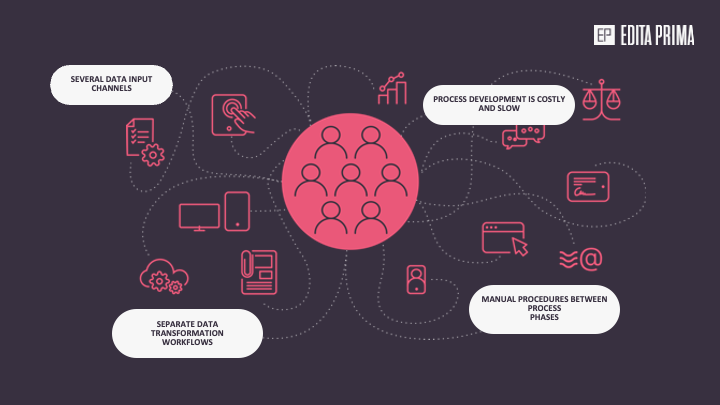Create online forms, implement integrations between systems, carry out transformations of customer and product data and personalise documents on one centralised platform.

The importance of cloud services such as Netflix, Facebook, Teams, etc., in people’s everyday life has become considerable. These services also act as benchmarks for other businesses that offer digital services. Businesses are expected to provide an intuitive and easy-to-use online service to customers both in B2B and B2C commerce.
For example, high-quality online services are absolutely crucial to businesses in the banking, insurance and finance sectors. They improve the user experience as well as the sense of reliability of the service. Comprehensive and easy-to-use online services also create opportunities for businesses to grow their existing customer accounts. If this is the goal, the customer journey must be easy and quick from the request for a quote to signing a contract.
The service experience provided to the customer can no longer be built on one-way communication that is based on documents and forms. Instead, it must be possible for customers to deal with matters related to them through an easy-to-use online service when they want to and in the channel of their choice.
Online services must also be able to quickly direct customers to the right content, identify the customer and offer them simple ways to order new services or make changes to the contents of their existing services.
Meeting these requirements increases the amount of customer data and naturally sets new kinds of requirements for data processing.
How, then, should this continuously growing amount of customer data be managed in order for it to best serve the needs of the company’s business? Especially when the following challenges, among others, make the use of data for the good of customers more difficult:
The regulations that control the activities change constantly.
There are direct interfaces between systems or data is transferred manually.
The processes related to the production and maintenance of documents and messages to customers have multiple stages and are slow and difficult to monitor.
At the same time, insufficient resources have to be allocated to the design and implementation of customer communications and the change management of official documents.
In organisations, business processes are steered in silos without holistic management of the customer experience.
The examples above are very common in Finnish businesses in the banking, insurance and finance sectors. This means that operations related to customer communications and documents become slow and complex.

Customer Communications Management – what is it?
A customer communications management (CCM) system is a technology platform that is able to receive data in various formats and from various sources, use the data to produce messages (e.g., terms and condition of the service, bank statements, investment reviews, online messages) and distribute the generated documents to the selected publication channels.
Traditionally, CCM solutions have only been used for document-based one-way communication. To put it simply:
A CCM system receives customer and product data from various sources.
After this, the CCM system converts the data to the required format and produces the desired personalised documents.
Finally, the CCM system stores the generated documents in the required systems and distributes them to various distribution channels or publication platforms.
However, CCM systems can do a lot more than that. For example, IDC Market Scape (03/2022) states that modern CCM solutions should steer users towards two-way, multichannel customer communication instead of document-based one-way communication. At best, the customer’s journey in the online service can be tracked in real time and they can be offered the correct content when they need it.
Creating a good customer experience requires that all customer contact points are able to use all the available information about the customer. Achieving this requires seamless cooperation among different systems, people and business processes.
We at Edita Prima use a modern CCM solution to make this possible for our clients. We can combine multiple customer contact points and produce data-driven messages that are in line with the client’s brand. The reply channels built in the messages make genuine dialogue with customers possible.
Our CCM solution
At Edita Prima, we have been improving the customer experience produced by our clients’ services for years by using the market-leading Quadient Inspire technology.
With the help of our solution, we have, for example, automated individual business processes, such as the new customer’s onboarding experience. We have also built centralised customer communications platforms that cover the client’s entire business.
As a Finnish company, we are able to support all kinds of organisations deliver business value with the platform. Our experienced experts have carried out many transformation projects where the Quadient Inspire system has been successfully introduced.

Quadient Inspire
The market in CCM solutions in Northern Europe is currently going through a dramatic transformation. Many businesses have reassessed their digital communications strategy and ended up replacing their existing CCM system with a new system that meets today’s needs.
According to independent assessments, Quadient Inspire Flex is the leading CCM solution on the market. For example, the IDC Market Scape Report from 2022 positions Quadient as a market leader in this field. Our clients are increasingly choosing to have Quadient Inspire as part of their digital strategy in order to produce a better customer experience for their customers.
The wide range of installation, maintenance and integration options guarantees that Quadient Inspire can be seamlessly added to the existing technology infrastructure of a business.
Book an appointment for a discussion below, and in 15 minutes we can find out how you could benefit from the opportunities offered by a modern CCM platform!
